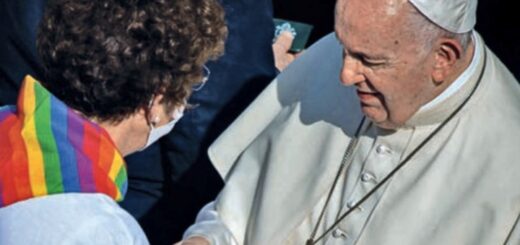The pink triangle, an inadequate symbol of gay pride
Article by R. Amy Elman* appearing on Journal of Homosexuality, volume 30, No. 3, 1-11, year 1996, and republished on the site remember.org (United States), freely translated by Virginia Campolongo
I found myself in front of a t-shirt shop in the heart of Greenwich Village, New York, and there, hanging in the window, was a white t-shirt with a drawing of a tree on it. Inside the tree there was a pink triangle dangling like a leaf from a branch and, below the image, the designer wrote: “The family tree ends here”.
This particular attempt to comically provide an alternative to conventional heterosexuality made a tragic impression on me, almost like the Nazi Heinrich Himmler, the most extremist homophobe at the head of the SS, who stated “We must destroy these people from head to toe… Homosexuals must be eliminated” (Plant, 1986, p.99). Evidently unaware of the fact that gays (and lesbians) can procreate through the well-known practice of sexual intercourse, Himmler defined homosexual man as “traitor of the country”, and therefore it should be “eradicated” because of his inability to reproduce. This is how awareness of the Holocaust vanishes. Amnesia hides the repugnant irony of contemporary faces.
Initially adopted by gay Americans in the early 1970s, after the 1969 Stonewall revolts, the pink triangle is currently used, internationally, as a symbol of liberation and gay and lesbian pride (1). This article aims to analyze the story linked to this symbol in depth, and carries out an argument against its use as the affirmation of gay identity in general, and the lesbian one in particular.
Since the upside -down pink triangle was used as a distinctive symbol of Nazi interseximism, which wanted the destruction, even rapid, of gays, therefore I argue that it is abandoned as a positive emblem of the movement. Like all Nazi symbols, this triangle is unrepentant. In addition, the mere fact of adopting the pink triangle by the lesbians hide all those struggles that the same lesbians have faced to establish themselves. Not only that, this adoption would lead to confusing lesbians with gays, thus mystifying their existence and their history during the Holocaust.
As Julia Penelope observes: "Our invisibility, also for ourselves, is, at least in a small part, due to the fact that our identity is divided into two groups: women and gay men" (1992, p.48). As a result, truths about the history, and even the present, of lesbianism are often dispersed, because sapphism itself is represented as socially unthinkable (Frye, 1983; Hoagland, 1988; Raymond, 1986, 1989; Robson, 1992). This condition is exacerbated by the gender neutrality of “queer melting pot” (Miriam, 1993). Lesbians have lost their autonomy (i.e., their “lesbian nation”) and, not surprisingly, the distinctive symbol of their pride: the symbol with two purple women is now almost extinct.
It is unseemly that girls and women, long chastised for forced pink identifiers, are now, as lesbians, convinced that a pink triangle is a symbol of gender rebellion. The inability to accept this situation contributes to an ever-increasing inability to distinguish all those associations and strategies that increase visible integrity from those that attempt to destroy it.
PINK TRIANGLE: GAY IDENTITY
The Third Reich used a myriad of colored triangles to identify the various groups of people held in concentration camps (2). The colors were: red for political dissidents, green for criminals, purple for Jehovah's Witnesses, blue for emigrants, brown for gypsies, black for lesbians and considered people “anti-social”, and pink for gays. The pink triangles symbolized the femininity of that group of prisoners, whose masculinity, in the light of Nazi heterosexism, was belittled. Furthermore, these triangles were generally larger than the others, as the Nazis' aim was to make all homosexuals more visible (Rector, 1981). On the contrary, Jews were identified by the yellow six-pointed Star of David, on which the word was engraved "Jew" (3).
The pink triangles identified the thousands of homosexual men who had been sent to concentration camps beneath the writing “175”. This number refers to the paragraph of the Penal Code, adopted in 1871, in which male homosexuality was considered criminal. This law was later extended, in 1935, to include any indecent behavior between two men; such "indecency" consisted of a “a small kiss or a hug, or a novel with homosexual content” and, for this crime, the "criminal" he had to serve six months in prison (Fernbach, 1980, p.11).
After 1936, gays were deported to concentration camps and, since they were never sent in groups, precisely because they were homosexual, few of them survived (5). Again, the persecution of gays has never been “systematic and en bloc” (Oosterhuis, 1991, p.248). Unlike the Jews, whose religious affiliation was ordinarily put in writing in the birth certificates, or as the people of the left, whose political sympathies were established by the party lists, gays were not easily identifiable. Above all, "Homosexual men were the only group ... who was not immediately selected for extermination in the territories conquered by the Nazis ..." (Plant, 1986, p.100), this is because Himmler was convinced that "The homosexuality between these people would bring them faster to the end" (Plant, 1986, p.99). Therefore, non-German gays were not as punished as the German ones. In truth, during the 1936 Olympic Games, some gay bars in Berlin was allowed to reopen, and the police were ordered not to annoy gay tourists (Plant, 1986, p.110; Rector, 1981).
The regime's reaction was not devoid of complications. Although homosexuality between men was firmly denounced, and gays, when discovered, paid the price with their own life, homoerotism was the basis of the "Male Cameraism" In the paramilitary organizations of the Reich, composed only of males (for example, the brown shirts of the SA, the Sturmabteilungen [the assault troops], the Hitlerian youth, and also theelite of the black uniforms of the SS, the Schtutzstaffeln [the protection teams] (6). When the voices on the obvious homosexual attitudes within the SA reached Hitler's ear, he said that the private life of the officers could not "Being the subject of specific investigations, unless this enters into contradiction with the principles at the base of the National Socialist ideology" (Plant, 1986, p.61).
But only when they know were unruly, Hitler ordered both the murder of the homosexual leader of the SA, Ernst Röhm, and the expulsion of any gay from Sa and the Nazi party. However, homoerotism continued to be the characterizing element of nationalist propaganda that fueled the movement (Theweleit, 1987): "Some gay artists took advantage of the protection of the Nazi hierarchs" (Oosterheuis, 1991, p.248). Moreover, the relationship between Hitler and his close collaborators was also imbued with homoerotic elements, in fact Hermann Göring, in this regard (once) said "Every time I find it [Hitler] in front, my heart ends up in my pants" (LeIDHoldt, 1983, p.21). During the whole domain of the third Reich, there was this contradiction, since on the one hand there were homosexual men who lived undisturbed in Germany, while on the other there were thousands of them who died in the concentration camps.
The Nazis did not unanimously consider gays to be biological degenerations. Many, in fact, believed that homosexuality was a contagious social disease, but still curable. Indeed, just 2% of those who were guilty of being gay were classified as “incorrigible”; for others however, the “re-education” could guarantee a possible recovery (Osterhuis, 1991, p.249).
Heinz Heger, sent first to Sachsenhausen concentration camp, and then to Flossenberg, explained that there it was believed that “those who had the pink triangle could have been 'cured' of their homosexuality, through compulsory and regular visits to the brothel” (1980, p.96). In those places, gypsy and Jewish women were forced into prostitution by the Nazis, and it was they who judged whether the men called “175” were healed. Castrations and testosterone injections were performed for "heal" gays and convert them to heterosexuality (Heger, 1980; Plant, 1986).
BLACK TRIANGLES: THE OCCULTATION OF LESBISM
The fact that the pink triangle is considered a symbol of liberation for gays and lesbians is disturbing, because that image was worn by those whom the Nazis labeled as gay (7). Unlike them, “all lesbians enjoyed a certain legal immunity” (Plant, 1986, p.27), but this was not due to the acceptance of the Lesbsm, indeed the relationships between women were not tolerated at all, so much so that the existence of the lesbians was sensationally denied.
Subsequently, in 1910, measures were taken into consideration to criminalize these women, but then they were immediately abandoned, as the feminist opposition was effective at a political level (Faderman & Eriksson, 1990, p. XV; Steakley, 1975, p. 42) (8). Consequently, paragraph 175 was not extended to lesbians; Yet, as is written more at the bottom, a male chauvinist company should find "Much more adequate means to suppress any type of female independence" (Fernbach, 1980, p. 10) (9).
The best way to make lesbians less and less powerful was to cut their relationships with other women. With the rise of Nazism, the meeting places for lesbians were subject to incursions (of the police), and their visibility was obscured (Faderman & Eriksson, 1990, p. XX) (10). "Lesbians", wrote Irene networks, "They were part of that group of women locked up in the fields as asocial, and considered a threat from German society even before 1939" (1993, p. 95) (11). All the people judged asocial were identified with upside -down black triangles, and the prisoners who wore them were "Considered stupid, unable to communicate, without courage in defending a brother [sic]" (Plant, 1986, p. 160). The SS despised them, as "The color of their triangles was an insult to their black uniforms" (Plant, 1986, p. 10).
It is politically significant to remember that the group of asocials did not only include lesbians, but it was a varied group, which included prostitutes, wandering, killers, thieves, and all those who broke the laws for which sexual relations between Aryans and Jews were prohibited . Precisely because the group of asocials was so heterogeneous, lesbians were not immediately recognized as gays, whose pink mark indicated their sexual orientation. Making the pink triangle today a universal symbol, would mean making lesbians invisible, as has happened in the past with black triangles. Not understanding this concept would bring several fundamental aspects of the history of fascism to the oblivion.
Even in the Museum of Memory on the Holocaust, in Washington DC, built recently, it is almost impossible to find exact information on lesbians (12). THE'Holocaust encyclopedia it is accessible via computers in a specific area of the museum, and if you do research using the word specifically "lesbian", results will come out that only concern homosexual men. Both the pink triangle and paragraph 175 appear on the screen, leading one to believe that they also refer to lesbians. In a historical period in which those who deny the Holocaust take advantage of any error to attack all the studies on the subject done up to now, we need to pay even more attention to the facts.
Many lesbians, in an attempt to respect history, wear the black triangles, and this is understandable since, having the desire to respect historical accuracy, it is right that they want to show that they are descendants of the women marked by the black triangles, and not of the men with the pink triangle. However, this is an unsatisfactory solution, because the idea of historical accuracy is inextricably linked to an ethical question, too often overlooked, which is impossible to answer, and it is the following: Isn't it immoral that a symbol, used to indicate a group of people and their extermination, is used as an emblem of liberation? Furthermore, how might survivors of such persecution feel when they see that symbol so horrendous for them again?
While young gays and young lesbians may have the luxury of wearing and removing these symbols of hate, those who survived the extermination camps cannot erase the numbers tattooed on their skin, which thus become permanent and painful, like those terrible memories that they carry with them and that can never be erased.
THE YELLOW STAR AND THE JEWISH COMMUNITY
The Jewish community refuses to wear yellow stars, not because anti-Semitism has disappeared (13), but because, rightly, any type of anti-Semitic emblem and label is rejected. The community is aware of the politics of symbols. In the early stages of the anti-Semitic policy, the Nazis were very insistent on the cancellation of assimilation; while Zionists argued that Jews should fight anti-Semitism by showing “proudly being Jewish” (Dawidowicz, 1986, p. 176).
In response to the first ban on Jewish activities, April 1, 1933, known as the Nazi boycott of Jewish trade, the Zionists argued that the Jews “wear with pride” the yellow star (14). This statement, made by Robert Weltsch, editor of a Jewish newspaper, became one of the best-known slogans of that time, “more than six years before the Nazis forced Jews to wear the symbol” (Arendt, 1977, p. 59). This slogan was used specifically against assimilationists, accused by the Zionists of having betrayed the Jewish community (15).
In hindsight, Weltsch said that "He would never have conceived that slogan if he had known what would happen" (Arendt, 1977, p.59). Ironically, this famous character contributed to facilitating the forced residence and movements in favor of restrictions towards the Jews, which led the police to increase the control measures, which allowed to keep in charge, everywhere, any Jew at any time . Furthermore, "Identification had a paralyzing effect" In the Jewish community since, being constantly under examination and identification, the Jews became, compared to before, much more meek and sensitive to the orders of the Nazis. This, according to the scholar of the Raul Hilberg Holocaust, was the most serious consequence to which he brought the yellow star (1961, p.121).
The claims of the claim
It is absurd that those who seek to achieve freedom focus on the past and claim that the Nazi symbol can be proudly used to achieve freedom. No group that survived the concentration camps, except homosexual men, ever proudly claimed the use of that symbol, which meant death for them. But, unlike any other persecuted group, gays' demands to be commemorated as victims of Nazism have been ignored (Heger, 1980, pp. 114-115; Rector, 1981, pp.139-141), and this is not occurred because historians question their having been victims, “but because many don't seem to care” (Rector, 1981, p.123). While the refusal to acknowledge the Nazis' tyranny of homosexuals is unforgivable, adopting the symbols of such persecution can only find support among those who ignore the past. Undoubtedly, using such a sign could have the unintended consequence of hiding Holocaust awareness, not promoting it (16).
Feminist scholar and philosopher Joan Ringelheim asks: “How can we so blithely claim and consider right something that has caused such oppression, without even doing a thorough investigation of our motives and policies?”; furthermore, it also states that the use of derogatory words, such as 'kike' and 'fagot' (English words referring to Jews and homosexuals), demonstrate how all those trying attempts will not be able to realize "As long as the words used by the oppressors continue to be charged with negativity" (Ringelheim, 1993, p.386).
In the same way, I argue that the new "transformed" triangle (pink or black) cannot be changed through the "claim": this concept is wrong, since these modified triangles have never belonged to those who had to wear them. Moreover, the fact of using them as symbols of pride would implicitly mean denying the cruel meaning they conceal; Consequently, wearing these Nazi symbols can be seen as a form of revisionism.
At this point, why not adopt the symbols of life and love, instead of those of sadism and destruction? Why did the color of the rebellion become pink, and not purple? And why not adopt symbols with two men or two women?
The answer, in part, could be historical ignorance, but it could also be internalized heterosexism; The propensity to embrace just those symbols connected to destruction (and death) reflects a huge amount of hatred and self -contempt. In a historical period of AIDS and revisionism, it is frighteningly fortuitous that the symbols with which we currently identify ourselves come from a period of death and totalitarianism. It is not possible to eradicate the triangles from their use in the extermination camps, where, as a survivor said, "Love became an immoral emotion for slaves, and sadistic fun for supervisors" (Lengyel, 1993, p.129).
A person cannot effectively eliminate oppression by imitating its language, actions, symbols of the oppressor. To avoid the "Enhancement of the oppressor" (Ringelheim, 1993), we must find our own language, our spaces and symbols, and we must do all this if we want a future considerably different from the past. In "finding" the ruthless emblems of Nazism, we do not transcend the criteria they established; We deceive ourselves because convinced we have control of it, we please and, perhaps, we become accomplices of our ruin.
NOTES
1) In a culture that “Americanizes” history, sexualizes domination, and is undeniably imperialistic, this should not be surprising. For an in-depth analysis of the Americanization of the Holocaust, I recommend reading Paul Gourevitch's (1993) article on the National Holocaust Memorial Museum, as it contains much important information, including the similarity between particular exhibits and the peep show (rooms equipped to allow the viewing of live female nudes).
2) For the Jews, the triangle was a symbol of truth (Cirlot, 1962, p.223). In cosmic and geometric symbolism the triangle symbolizes the connection between Earth and Paradise (Cirlot, 1962, p.16). In the sacred Greek alphabet, triangles represent the vulva of the “Delta Mother” (Walkner, 1983, p.1016). It is understandable, knowing the contempt that the Nazis had for the truth, for the Jews and for everything feminine, that the Third Reich used the upside-down triangle to denigrate all those who it forced to wear it.
3) Jewish homosexual men were forced to wear a yellow triangle under the pink one, and it is from the union of these that the Star of David was born. Additionally, communist Jews wore the yellow triangle under the red one, and so on (Rector, 1981, pp.131-132).
4) Harry Oosterhuis points out that German researchers estimated that between 5,000 and 15,000 gays died in concentration camps (and those who were interned and then released were not included).
5) For one of the few reports on the topic, I recommend reading “The Man with the Pink Triangle” (1980) by Heger.
6) The SA was Hitler's mass paramilitary organization, which proved particularly important before his [Hitler's] seizure of power. They were created to protect Nazi rallies, to oppose rival political parties (often through street fights), and to spread propaganda. The SS, on the other hand, was rather elitist and was an armed force that ran the concentration camps.
7) The Simon Wiesenthal Center for Holocaust Studies in Los Angeles reports that: “One of the biggest problems with the Nazis' treatment of homosexuals was the lack of authentic documents on the subject.” (Rector, 1981, p.108). Although there were few documents on gays in the extermination camps, there are none at all on lesbians; in fact, while Heinz Heger provides us with a precious memoir on the survival of gays (1980), there is nothing on lesbians. Furthermore, since homosexuals were officially prosecuted, and were recognizable by pink triangles, they were put in the spotlight; consequently, there are some mentions of their treatment in the camps. In contrast, lesbians were "Hidden by the double veil of hypocrisy and silence" (Laska, 1993, p.264). This section investigates this concealment.
8) For example, the League for the protection of motherhood and sexual reform made a motion approved in 1911 that defined a proposal for criminalization of lesbians "A serious mistake", which would only have "Dual injustice" duplicate ".
9) Gay men were - and are - defined individually with the synonym of "homosexual", and publicly persecuted as such through criminal proceedings; The contempt for lesbians was, as is still still, expressed through obscurantism and from "Clearly to those women who organize themselves to obtain a public presence, a political and social weight, and an evident integrity" (DWorkin, 1993, p.28).
10) Before that there were about sixty meeting points for lesbians in Berlin; In addition, there was a newspaper exclusively for lesbians, "The Girlfriend: weekly for an ideal friendship" (Faderman & Eriksson, 1990, p.xxi).
11) Subsequently, the war against them almost completely decreased efforts to exterminate the Jews of Europe.
12) Andrea Dworkin writes: "Within the museum, the history of women is missing" (1994, p.54).
13) For a more complete vision on anti -Semitism in the United States from colonialism so far, I suggest reading Dinnerstein (1994).
14) It is interesting to note how the yellow symbol, born as an official emblem of protection during the Middle Ages, was casually extended to Jews in Muslim territories. The sign served to remind the latter that it was forbidden to attack Jews (Biale, 1987, p.67); consequently, it served to distinguish and protect them. It is thought that it was probably this history that pushed the Zionists to adopt this particular symbol.
15) In turn, the assimilationists blamed the Zionists for their persecution, claiming that the Zionists, who had always emphasized their Jewishness, were an obstacle to peaceful coexistence. Furthermore, assimilationists insisted that Jews remain loyal to the “German spirit” (Dawidowicz, 1986, p.174). What both the Zionists and the assimilationists did not consider is that their greatest mistake was not their behavior, but rather the fact that they were born Jews (Elman, 1989). Of course, in hindsight, one might observe, as Sartre did, that “the true antagonist of assimilation is not the Jew, but the anti-Semite…” (Sartre, 1969, p.143).
16) In recent years I have often asked those who wore pink triangles to explain their meaning, and rarely I was given an exhaustive response. Many respond by simply saying that it symbolizes gay and lesbian pride. Furthermore, with the exception of the survivors of the Holocaust that oppose the indossible, those who are not part of the gay community, nor of the lesbian one, are even less aware of the historical value of the triangle. He strongly suspected that the attraction towards this emblem is due precisely to his being abstruse, little known, that is, that the pink triangle is a "circumspect" signifier.
* R. Amy Elman is an assistant to political science at the University of Kalamazoo, where he gives lessons on the Holocaust and other European issues from the point of view of women. The author wishes to thank Katinka Strom, Marigene Arnold, Peter L. Corrigan, Gail Griffith, and Donna Hughes for having encouraged her to concentrate and specialize on this theme.
Original text: Triangles and Tribularations: The Politics of Nazi Symbols






